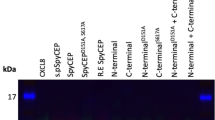Abstract.
Serralysin is a bacterial Zn-endopeptidase which has been considered a virulence factor to cause tissue damage and anaphylactic response. It contains a coordinated Tyr that is unique to the astacin-like Zn enzymes. The coordinated Tyr has been proposed to play an important role in the action of this endopeptidase family. Several metal-substituted derivatives of serralysin (including Mn2+, Co2+, Ni2+, Cu2+, and Cd2+ derivatives) are found to exhibit significant activities. Particularly, the Co- and Cu-substituted derivatives exhibit much higher activities than the native serralysin toward the hydrolysis of the tripeptide mimic benzoyl-Arg-p-nitroanilide, i.e., 35 and 49 times higher in k cat and 33 and 26 times in k cat/K m, respectively. Such remarkably higher activities of metal-substituted derivatives, especially the Cu derivative, than that of the native Zn enzyme are rare in the literature, reflecting the uniqueness of this enzyme among all Zn enzymes. The significantly different k cat yet similar K m values among the several metal derivatives suggests that the metal center is involved in catalysis, but not necessarily in the binding of the substrate, whereas the dramatically different inhibition constants for Arg-hydroxamate binding to the metal-substituted derivatives indicates direct binding of this inhibitor to the metal center. The activity-pH profiles of serralysin and its Co2+ and Cu2+ derivatives and the optical-pH profile of Cu-serralysin have been obtained, in which the decrease in activity at higher pH values was found to be associated with a dramatic increase in the Tyr-to-Cu2+ charge transfer transitions. This observation suggests that the binding of Tyr216 to the metal is inhibitory. A metal-centered mechanism is proposed for serralysin catalysis based on the results presented here, in which the detachment of the coordinated Tyr and formation of a H-bond with the transition-state complex are considered essential for the stabilization of the transition state.
Similar content being viewed by others
Author information
Authors and Affiliations
Additional information
Electronic Publication
Rights and permissions
About this article
Cite this article
Park, H., Ming, LJ. Mechanistic studies of the astacin-like Serratia metalloendopeptidase serralysin: highly active (>2000%) Co(II) and Cu(II) derivatives for further corroboration of a "metallotriad" mechanism. J Biol Inorg Chem 7, 600–610 (2002). https://doi.org/10.1007/s00775-002-0338-2
Received:
Accepted:
Published:
Issue Date:
DOI: https://doi.org/10.1007/s00775-002-0338-2




